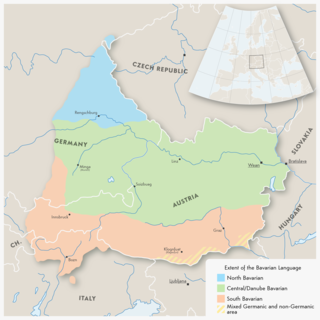Austro-Bavarian language
major group of Upper German varieties spoken in the southeast of the German language area Bavaria From Wikipedia, the free encyclopedia
Remove ads
Bavarian (also known as Austro-Bavarian; German: Bairisch, Bayerisch-Österreichisch) [ˈbaɪ̯ʁɪʃ] (![]() listen)) is a major group of Upper German varieties. They are called "upper" because they are spoken in Switzerland, Austria and southern Germany, which are mountainous. Like standard German, Austro-Bavarian is a High German language, but they are not the same language. However, Austro-Bavarian and Standard German have influenced each other and the vast majority of Austro-Bavarian speakers speak Standard German as well. There are more variants of Bavarian. The variants are Central Bavarian, Southern Bavarian, and Northern Bavarian.
listen)) is a major group of Upper German varieties. They are called "upper" because they are spoken in Switzerland, Austria and southern Germany, which are mountainous. Like standard German, Austro-Bavarian is a High German language, but they are not the same language. However, Austro-Bavarian and Standard German have influenced each other and the vast majority of Austro-Bavarian speakers speak Standard German as well. There are more variants of Bavarian. The variants are Central Bavarian, Southern Bavarian, and Northern Bavarian.
Austro-Bavarian is also used to refer to the dialect group which includes the Austro-Bavarian dialect discussed here, as well as the Cimbrian, Hutterite German, and Mócheno dialects of Germany.
Remove ads
History and origin
The Austro-Bavarian language has its origins in the Germanic tribe known as the Bavarii, who established a tribal duchy, which covered much of what is today Bavaria and some of Austria in the early Middle Ages and was eventually subdued by Charlemagne. However, they gradually migrated down the Danube and into the Alps to all those areas where Austro-Bavarian dialects are spoken.
In German, there is usually a difference made between "bairisch" (referring to the language) and "bayerisch" (referring to the state of Bavaria and used in the name of BMW). Because of King Ludwig I's passion for everything Hellenic, the German name for Bavaria today is spelled "Bayern", while the language spoken there has retained its original spelling "Bairisch"—note the I versus the "Hellenic" Y.
Remove ads
Regions where people speak Bavarian
- in Bavaria:
- in Upper Bavaria
- in Lower Bavaria
- in the Upper Palatinate
- in Austria:
- in all parts of the country except the federal-state of Vorarlberg and parts of the Reutte District in Tirol, where an Alemannic dialect is spoken.
- in Switzerland:
- in the village of Samnaun, in Graubünden.
- in Italy:
- in all of the province of South Tyrol and by small German speaking communities in Trento, Veneto (Cimbrian language) and Friuli.
- in Hungary:
- the city of Sopron (Ödenburg) is officially bi-lingual.
Remove ads
Diphthongs
Consonants
Notes:
- The phoneme /h/ is frequently realised as [ç] or [x] word-internally and is realised as [h] word-initially.
- Intervocalic /s/ can be voiced to [z].
- A trill sound /r/ may also be realised as a tap sound [ɾ].
- Intervocalic /v/ or /w/ sound can be realised as [ʋ] or [β, w].
- Some dialects, such as the Bavarian dialect in South Tyrol, realise /k/ as an affricate [k͡x] word-initially and before /m, n, l, r/, which is an extension of the High German consonant shift to velar consonants.
Vowels
Examples of Bavarian and Austrian
Remove ads
Related pages
References
Wikiwand - on
Seamless Wikipedia browsing. On steroids.
Remove ads

